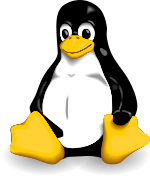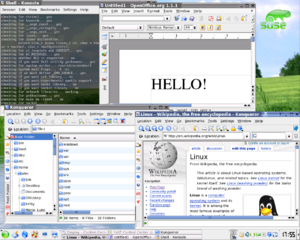Linux
2007 Schools Wikipedia Selection. Related subjects: Software
Linux (also known as GNU/Linux) is a Unix-like computer operating system. It is one of the most prominent examples of open source development and free software; its underlying source code is available for anyone to use, modify, and redistribute freely.
Initially developed and used primarily by individual enthusiasts on personal computers, Linux has since gained the support of corporations such as IBM, Sun Microsystems, Hewlett-Packard, and Novell, Inc., and has risen to prominence as an operating system for servers; eight of the ten most reliable internet hosting companies now run Linux on their web servers.
Linux has been more widely ported to different computing platforms than any other operating system. It is used in devices ranging from supercomputers to mobile phones, and is gaining popularity in the personal computer market.
History
Early

In 1983, Richard Stallman founded the GNU Project, with the goal of developing a complete Unix-like operating system composed entirely of free software. By the beginning of the 1990s, GNU had produced or collected most of the necessary components of this system — libraries, compilers, text editors, a Unix shell — except for the core component, the kernel. The GNU project began developing a kernel, the GNU Hurd, in 1990, based on the Mach microkernel, but the development of this Mach-based design proved difficult and proceeded slowly.
Meanwhile, in 1991, another kernel was begun as a hobby by Finnish university student Linus Torvalds while attending the University of Helsinki. Torvalds originally used Minix on his own computer, a simplified Unix-like system written by Andrew Tanenbaum for teaching operating system design. However, Tanenbaum did not permit others to extend his operating system, leading Torvalds to create a replacement for Minix.
Originally, Torvalds called his kernel "Freax" for "free" and "freak" and with the often-used X in the names of Unix-like systems. The name "Linux" was coined by Ari Lemmke, who administered an FTP server belonging to the Finnish University Network; he invented the name Linux for the directory from which Torvalds' project was first available for download.

At first a computer running Minix was necessary in order to configure and install Linux. Initial versions of Linux also required another operating system to be present in order to boot from a hard disk, but soon there were independent boot loaders such as LILO. The Linux system quickly surpassed Minix in functionality; Torvalds and other early Linux kernel developers adapted their work for the GNU components and user-space programs to create a complete, fully functional, and free (as in freedom) operating system.
Today, Torvalds continues to direct the development of the kernel, while other subsystems such as the GNU components continue to be developed separately. Other groups and companies combine and distribute these components with additional application software in the form of Linux distributions.
Linux and the GNU Project

The goal of the GNU project is to produce a Unix-compatible operating system consisting entirely of free software, and most general-purpose Linux distributions rely on GNU libraries and tools written to that effect. The Free Software Foundation views these Linux distributions as "variants" of the GNU system, and asks that such operating systems be referred to as GNU/Linux or a Linux-based GNU system. While some distributions make a point of using the combined form - notably Debian GNU/Linux - its use outside of the enthusiast community is limited, and Linus Torvalds has said that he finds calling Linux in general GNU/Linux "just ridiculous". The distinction between the Linux kernel and distributions based on it is a source of confusion to many newcomers, and the naming remains controversial.
SCO litigation
In March 2003, the SCO Group filed a lawsuit against IBM, claiming that IBM had contributed portions of SCO's copyrighted code to the Linux kernel in violation of IBM's license to use Unix. Additionally, SCO sent letters to a number of companies warning that their use of Linux without a license from SCO may be actionable, and claimed in the press that they would be suing individual Linux users. This controversy has involved lawsuits by SCO against DaimlerChrysler (dismissed in 2004), and AutoZone, and by Red Hat and others against SCO. Furthermore, whether SCO even owns the relevant Unix copyrights is currently disputed by Novell.
As per the Utah District Court ruling on July 3, 2006; 182 claims out of 294 claims made by SCO against IBM have been dismissed.
SCO's claims have varied widely. As of 2006, no proof of SCO's claims of copied code in Linux has been provided.
Portability
The Linux kernel was originally designed only for Intel 80386 microprocessors, but now supports a wide variety of computer architectures. Linux is one of the most widely ported operating systems, running on a diverse range of systems from the hand-held ARM-based iPAQ to the mainframe IBM System z9. Specialized distributions exist for less mainstream architectures. The ELKS kernel fork can run on Intel 8086 or 286 16-bit microprocessors. There are even ports to atypical devices such as iPods and consoles.
Copyright, licensing, and the Linux trademark
The Linux kernel and most GNU software are licensed under the GNU General Public License. The GPL requires that all distributed source code modifications and derived works also be licensed under the GPL, and is sometimes referred to as a "share and share-alike" or " copyleft" license. In 1997, Linus Torvalds stated, "Making Linux GPL'd was definitely the best thing I ever did." Other software may use other licenses; many libraries use the GNU Lesser General Public License (LGPL), a more permissive variant of the GPL, and the X Window System uses the MIT License.
In the United States, the name Linux is a trademark registered to Linus Torvalds. Initially, nobody registered it, but on August 15, 1994, William R. Della Croce, Jr. filed for the trademark Linux, and then demanded royalties from Linux distributors. In 1996, Torvalds and some affected organizations sued to have the trademark assigned to Torvalds, and in 1997 the case was settled. The licensing of the trademark is now handled by the Linux Mark Institute. Torvalds has stated that he only trademarked the name to prevent someone else from using it, but was bound in 2005 by United States trademark law to take active measures to enforce the trademark. As a result, the LMI sent out a number of letters to distribution vendors requesting that a fee be paid for the use of the name, and a number of companies have complied.
Pronunciation
In 1992, Torvalds explained how he pronounces the word Linux ( IPA: /'lɪnʉks/)
| “ | 'li' is pronounced with a short [ee] sound: compare prInt, mInImal etc. 'nux' is also short, non-diphthong, like in pUt {IPA /ʊ/}. It's partly due to minix: linux was just my working name for the thing, and as I wrote it to replace minix on my system, the result is what it is... linus' minix became linux. | „ |
|
—Linus Torvalds, comp.os.linux newsgroup |
||
An audio file of Torvalds saying "Hello, this is Linus Torvalds, and I pronounce Linux as Linux" can be found here. Note that in English, "Linux" and "Minix" are usually pronounced with a short i ( IPA: /ɪ/) sound that is different from Torvalds' Finland Swedish pronunciation of these words.
Development
More Than a Gigabuck: Estimating GNU/Linux's Size, a 2001 study of Red Hat Linux 7.1, found that this distribution contained 30 million source lines of code. Using the Constructive Cost Model, the study estimated that this distribution required about eight thousand man-years of development time. According to the study, if all this software had been developed by conventional proprietary means, it would have cost about 1.08 billion dollars (year 2000 U.S. dollars) to develop in the United States.
The majority of the code (71%) was written in the C programming language, but many other languages were used, including C++, Lisp, assembly language, Perl, Fortran, Python and various shell scripting languages. Slightly over half of all lines of code were licensed under the GPL. The Linux kernel was 2.4 million lines of code, or 8% of the total.
In a later study, Counting potatoes: The size of Debian 2.2, the same analysis was performed for Debian GNU/Linux version 2.2. This distribution contained over fifty-five million source lines of code, and the study estimated that it would have cost 1.9 billion dollars (year 2000 U.S. dollars) to develop by conventional means.
Distributions
Linux is predominantly used as part of a Linux distribution (commonly called a "distro"). These are compiled by individuals, loose-knit teams, and commercial and volunteer organizations. They commonly include additional system and application software, an installer system to ease initial system setup, and integrated management of software installation and upgrading. Distributions are created for many different purposes, including computer architecture support, localization to a specific region or language, real-time applications, and embedded systems, and many deliberately include only free software. Currently, over three hundred distributions are actively developed, with about a dozen distributions being most popular for general-purpose use.
A typical general-purpose distribution includes the Linux kernel, some GNU libraries and tools, command-line shells, the graphical X Window System and an accompanying desktop environment such as KDE or GNOME, together with thousands of application software packages, from office suites to compilers, text editors, and scientific tools.
Desktop usage

The high level of access granted to Linux's internals has led to Linux users traditionally tending to be more technologically oriented than users of Microsoft Windows and Mac OS, sometimes revelling in the tag of " hacker" or " geek". Linux and other free software projects have been frequently criticized for not going far enough to ensure ease of use.
This stereotype has begun to be dispelled in recent years. Linux may now be used with a user interface that is very similar to those running on other operating systems. However users may have to switch to alternative application software, and there are often fewer "known" software choices (as in the case of computer games) but there exist replacements for all general-purpose software, and general applications like spreadsheets, word processors, and browsers are available for Linux in profusion. Additionally, a growing number of proprietary software vendors are supporting Linux, and compatibility layers such as Wine or NdisWrapper allow some Windows application software and drivers to be used on Linux without requiring the vendor to adapt them.
Linux's roots in the Unix operating system mean that in addition to graphical configuration tools and control panels available for many system settings and services, plain-text configuration files are still commonly used to configure the OS and can readily be made accessible (or not) to users, at the administrator's will.
The Berlin-based organization Relevantive concluded in 2003 that the usability of Linux for a set of desktop-related tasks was "nearly equal to Windows XP." Since then, there have been numerous independent studies and articles which indicate that a modern Linux desktop using either GNOME or KDE is on par with Microsoft Windows in a business setting.
Enterprise usage
Linux has historically been used mainly as a server operating system, but its low cost, flexibility, and Unix-like architecture make it suitable for a variety of applications. Linux is the cornerstone of the " LAMP" server-software combination (Linux, Apache, MySQL, Perl/PHP/Python) which has achieved popularity among developers, and which is one of the more common platforms for website hosting.
Due to its low cost and its high configurability, Linux is often used in embedded systems such as television set-top boxes, mobile phones, and handheld devices. Linux has become a major competitor to the proprietary Symbian OS found in many mobile phones, and it is an alternative to the dominant Windows CE and Palm OS operating systems on handheld devices. The popular TiVo digital video recorder uses a customized version of Linux. Several network firewall and router standalone products, including several from Linksys, use Linux internally, using its advanced firewalling and routing capabilities.
Linux is increasingly common as an operating system for supercomputers. For example, in the November 2005 TOP500 list of supercomputers, seven of the top ten supercomputers in the world, including the two fastest, ran Linux. Of the 500 systems, 371 (74.2%) ran Linux.
Market share and uptake
According to the market research company IDC, 25% of servers and 2.8% of desktop computers ran Linux as of 2004. Proponents and analysts attribute the success of Linux to its security, reliability, low cost, and freedom from vendor lock-in. The frictional cost of switching and lack of support for some hardware and many application programs designed for Windows, especially games or uncommon business software, are two important factors inhibiting adoption.
The Linux market is rapidly growing and the revenue of servers, desktops, and packaged software running Linux is expected to exceed $35.7 billion by 2008. The actual installed user base may be higher than indicated by this figure, as most Linux distributions and applications are freely available and redistributable.
The paper Why Open Source Software / Free Software (OSS/FS)? Look at the Numbers! identifies many quantitative studies of open source software on topics including market share and reliability, with many studies specifically examining Linux.
Installation
The most common method of installing Linux on a personal computer is by booting from a CD-ROM that contains the installation program and installable software. Such a CD can be burned from a downloaded ISO image, purchased alone for a low price, obtained as part of a box set, or in a few cases shipped for free by request. A box set may also include manuals and additional proprietary software. Mini CD images allow Linux to be installed from a disk with a small form factor.
As with servers, personal computers that come with Linux already installed are available from vendors including Hewlett-Packard and Dell, although generally only for their business desktop line.
Alternatives to traditional desktop installation include thin client installation and running directly from a Live CD. In a thin client installation, the operating system is loaded and run from a centralised machine over a network connection. In a Live CD setup, the computer boots the entire operating system from CD without first installing it on the computer's hard disk.
On embedded devices, Linux is typically held in the device's firmware and may or may not be consumer-accessible.
Programming on Linux
The GNU Compiler Collection (GCC) is the standard compiler family for most Linux systems. Amongst others, GCC provides frontends for C, C++ and Java. Most distributions come installed with interpreters for Perl, Python and other scripting languages, and several now include C# via the Mono project.
There are a number of Integrated development environments available including MonoDevelop, KDevelop, Anjuta, NetBeans, and Eclipse while the traditional editors Emacs and Vim remain popular.
The two main widget toolkits used for contemporary GUI programming are Qt and the Gimp Toolkit, known as GTK+.
As well as these free and open source options, there are proprietary compilers and tools available from a range of companies such as Intel, PathScale, Micro Focus COBOL,, Franz Inc, and the Portland Group.
Support
Technical support is provided by commercial suppliers and by other Linux users, usually in online forums, IRC, newsgroups, and mailing lists. Linux User Groups have traditionally been organized to provide support for Linux in specific cities and regions.
The business model of commercial suppliers is generally dependent on charging for support, especially for business users. A number of companies offer a specialized business version of their distribution, which adds proprietary support packages and tools to administer higher numbers of installations or to simplify administrative tasks.

